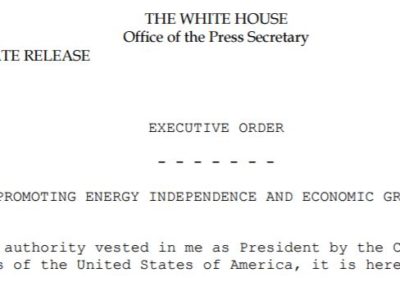Cost Benefit Analysis
200 Days & Counting: Pollution and Climate Change
Trump and Pruitt want to take an ax to EPA regulation. That will be harder than they think.
Rolling back EPA regulations is one of the Trump Administration’s priorities. The most notable example is Obama’s Clean Power Plan, which aimed to cut CO2 emissions from power plants. The other rule that has gotten considerable attention is the so-called WOTUS rule, which defines federal jurisdiction to regulate wetlands and watersheds. But these are not …
Continue reading “200 Days & Counting: Pollution and Climate Change”
CONTINUE READINGTrump’s Executive Order: Bad Policy and More Uncertainty
President Trump’s Executive Order on climate policy is an invitation to bad policymaking and legal uncertainty. The big-ticket item targeted by the Order, of course, is the Obama Administration’s Clean Power Plan and related rules on carbon dioxide emissions from power plants. The EO has limited immediate legal impact: none of the major rules can …
Continue reading “Trump’s Executive Order: Bad Policy and More Uncertainty”
CONTINUE READINGThe End of the Cost-Benefit State?
Trump is targeting regulations for elimination even if their benefits exceed their costs.
Some scholars have proclaimed a vision of the regulatory state centering on cost-benefit analysis (CBA). They mean that quantitive comparisons of costs and benefits is now the foundation of regulatory decisions, arguably blessed by the Supreme Court in one of Scalia’s last opinions. Environmentalists weren’t convinced this was a good idea. Neither, as it turns out, is Donald Trump. He doesn’t seem …
Continue reading “The End of the Cost-Benefit State?”
CONTINUE READINGLegal Mandates to Consider the Social Cost of Climate Change
Considering climate impacts isn’t just a good idea. It’s the law.
Many people seem to think that considering climate impacts and the social cost of carbon was just a policy decision by the Obama Administration, which Trump if he doesn’t buy the reality of climate change. But it’s not that easy. But there are strong arguments that considering climate change is mandatory. First, the whole idea of considering …
Continue reading “Legal Mandates to Consider the Social Cost of Climate Change”
CONTINUE READINGTurnabout is Fair Play
The same tools that have been used to stymie the Obama Administration can be turned against Trump.
Conservatives and industry have perfected some legal tools to block regulation by the Obama Administration. Those tools can be turned against them, by using the same tools to block anti-regulatory moves by the Trump Administration. As a professor, I don’t necessarily agree with all of them. But as a lawyer, I wouldn’t hesitate to use them …
Continue reading “Turnabout is Fair Play”
CONTINUE READINGThe Clean Power Plan — Low Cost, High Benefits
Despite claims by industry and conservatives, the CPP’s costs are completely manageable.
The Supreme Court’s stay of EPA’s Clean Power Plan was a surprise, and a questionable action on many grounds. It now seems clear that the stay — along with much of the political fuss about the CPP — was based on very questionable economics. In terms of the stay, a team of economists at Resources …
Continue reading “The Clean Power Plan — Low Cost, High Benefits”
CONTINUE READINGThe Supreme Court Vacancy and EPA’s Mercury Rule
The rule limiting toxic pollution from coal plants now has a rosier future.
Among the many ramifications of the current vacancy on the bench, its effect on the EPA’s mercury rule seems to have escaped much attention. It may already have helped EPA defeat an effort by states to get a stay from Chief Justice Roberts. But it has much broader significance. Some background: The Supreme Court, in a …
Continue reading “The Supreme Court Vacancy and EPA’s Mercury Rule”
CONTINUE READING“Necessary and Appropriate”
EPA has now formally proposed its response to the Supreme Court’s opinion in Michigan v. EPA
Although the Paris talks are justifiably getting the lion’s share of the attention, there have been other significant environmental actions recently. One of those involves the EPA’s effort to reduce toxic emissions from power plants (particularly coal-fired plants). The Clean Air Act gives special treatment to toxic emissions from power plants. Other sources are regulated …
Continue reading ““Necessary and Appropriate””
CONTINUE READINGThe Shadow Price of Carbon
Merging Cost-Benefit Analysis and Feasibility Analysis
The U.S. government has devoted a lot of time and effort to estimating the social cost of carbon. This is basically a standard exercise in cost-benefit analysis, following a familiar three-step process: 1. Impacts. Figure out the physical impacts of the emissions. This involves setting up some emissions scenarios and then running computer simulations to …
Continue reading “The Shadow Price of Carbon”
CONTINUE READINGMichigan v. EPA: Policymaking in the Guise of Statutory Interpretation
In Michigan v. EPA, the majority followed its own policy views, not those in the statute.
The majority opinion by Justice Scalia has gotten most of the attention. Most notably, he wrote that “[o]ne would not say that it is even rational, never mind “appropriate”, to impose billions of dollars in economic costs for a few dollars in health or environmental benefits.” Indeed, “[n]o regulation is ‘appropriate’ if it does significantly …
Continue reading “Michigan v. EPA: Policymaking in the Guise of Statutory Interpretation”
CONTINUE READING












